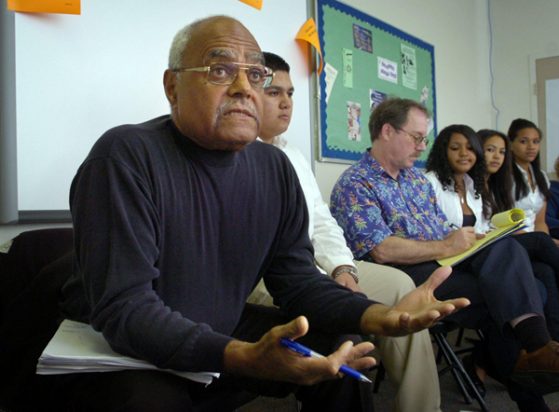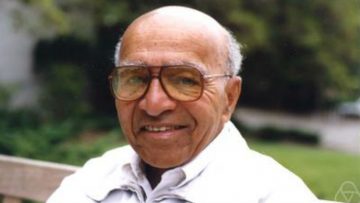October is Black History Month, a tradition that began in the US and was officially recognised there in 1976 as a month during which contributions of African Americans are celebrated and made visible. In the UK this tradition arrived in 1987 when the first Black History Month was celebrated in October of that year. To celebrate Black History Month in October 2021, I have chosen to discuss an inspirational mathematics educator, Robert Parris Moses (1935–2021), who died earlier this year. Moses was, apart from being a mathematics educator, also a well-known political activist in the US.
Moses was born and raised in Harlem, NY, and gained a BA in Philosophy from Hamilton College in 1956 and an MA in Philosophy from Harvard in 1957. Following his political engagement in the Mississippi Voter Registration Project in 1960, Moses went to Tanzania and taught at the Samé School for seven years. Upon his return to the US, Moses re-entered the doctoral programme in Philosophy at Harvard and taught mathematics in secondary school in Cambridge, Massachusetts, and later in Jackson, Mississippi.

In 1982, Moses began a project for which he became known worldwide – The Algebra Project. He was supported in this by the MacArthur Foundation. Thus, out of his political activism, his philosophy of justice and equality, and his love of teaching mathematics, a programme was born that uses grassroots activism to transform state schools’ teaching of algebra, making mathematics learning a focus and part of a mechanism that promotes students’ confidence and equips them with tools for their liberation from disadvantage. The project aimed to help students to access education more broadly, including mathematics rather than only social sciences. To be able to access mathematics, students had to begin speaking its language, and algebra therefore came into focus in Moses’s activism.
He saw this quest as a matter of supporting, en masse, an ability in kids of Black and other ethnic minorities, to catch up with the bus that was going to good places – places of prosperity, academic success, and technological advances [1, p. 15]:
My metaphor is that you’re running to get on board the bus. The bus is moving, and you can’t get on it from a standstill position. As your speed begins to approach the speed of the bus, you have a chance of hopping on.
The ‘catching up with the bus’ was of course incredibly important, but so was the ability to transfer the self-confidence and intellectual capacity that is developed with the study of mathematics to any area of a student’s life. This enables a life well lived, in which the student has the freedom to decide which path to take and to choose what contribution to make.
Of course, Moses was not the only person in the history of humankind to understand this. In fact, this is often seen by opposing forces in society. I will give you a couple of examples. First, Isaac Barrow (1630–1677), Newton’s teacher and the first holder of the Lucasian Chair in Mathematics at Cambridge (1663–1669), stated in his Mathematical Lectures [2] that
These Disciplines [mathematics] serve to inure and corroborate the Mind to a constant Diligence in Study; to undergo the Trouble of an attentive Meditation, and cheerfully contend with such Difficulties as lie in the Way. They wholly deliver us from a credulous Simplicity, most strongly fortify us against the Vanity of Scepticism, effectually restrain from a rash Presumption, most easily incline us to a due Assent, perfectly subject us to the Government of right Reason, and inspire us with Resolution to wrestle against the unjust Tyranny of false Prejudices.
We should also remember in this context, that on the other hand, those who seek to arrest such developments in young minds often do exactly the opposite, seeing precisely in the study of mathematics the dangers of learning to think. More than a century after Barrow, a Greek scholar who brought the (then) modern teaching of mathematics to his community in Smyrna, after he had completed his own studies at Leipzig, was seen as a usurper of order [3]:
Cubes and triangles, logarithms and symbolic calculus … bring apathy … jeopardizing our irreproachable faith.
With this exclamation by Patriarch Grigorios V, Constantinos Koumas was labelled as a dangerous revolutionary, and subsequently, his school was burnt down by an angry mob.
Both Barrow and Moses saw the study of mathematics as part of a broader training of how to think and participate in society. Barrow did this more so in relation to thinking, and Moses in relation to participation, but nevertheless they both considered mathematics as an important part of maintaining and developing a civilised society.
Bob Moses also proclaimed that, for students to participate fully in society, mathematics should be made accessible through programmes that are as grassroots as education can be. He looked at how the traditional function of mathematics education in the US was to identify potential mathematicians and help them join university programmes. However, this process was self-selecting. Before getting to any interesting work, much learning of abstract mathematics had to be undertaken, which is not the same in all school subjects. If you study art, you do get to paint sometimes; in languages you learn how to write stories and poems, and in music you play instruments, even if badly.
So, what Moses did was to make algebra a collaborative project between the students. They taught each other, guided by their teachers, how to make beautiful equations based on practical work and created group and individual ‘stories’ around how mathematics works.
This project is still ongoing, of course. Moses’s involvement, and the project itself, benefits all the students and teachers who are part of it, regardless of the colour of their skin. What Moses did was increase confidence by acting as a role model and giving space and time to the thousands of teachers and students to see themselves as creators and participants, rather than only as exam takers, in the beautiful landscape of mathematics.
Snezana Lawrence FIMA
Middlesex University
References
- Moses, R.P. and Cobb, C.E., Jr. (2001) Radical Equations: Civil Rights from Mississippi to the Algebra Project, Beacon Press, Boston.
- Barrow, I. (1734) Mathematical Lectures Given 1664–1669, printed for Stephen Austen, London.
- Lawrence, S. (2008) A Balkan trilogy: mathematics in the Balkans before the First World War, in The Oxford Handbook of the History of Mathematics, eds Robson, E. and Stedall, J., Oxford University Press, Oxford.
Reproduced from Mathematics Today, October 2021
Download the article, Historical Notes: Moses Closes the Gap (pdf)



